Overview
During our audit, we identified the following instances of noncompliance with the report filing requirements of Executive Order (EO) 526 and related guidance provided by the Human Resources Division (HRD):
- Although each executive agency’s most recent affirmative action plan was required to be submitted to HRD by September 15, 2017, 12 of the 65 executive branch agencies that were required to submit these plans had not done so as of the date of our audit testing in this area (May 25, 2018).
- Of the remaining 53 agencies that were required to submit affirmative action plans to HRD by September 15, 2017, 50 submitted them after the due date.
- Although each agency’s most recent diversity plan was required to be submitted to HRD by September 15, 2017, 15 of the 67 agencies that were required to submit these plans had not done so as of the date of our audit testing in this area (May 25, 2018).
- Of the remaining 52 executive branch agencies that were required to submit diversity plans to HRD by September 15, 2017, 49 submitted them after the due date.
Overall, 18 different executive departments had not submitted at least one of the required plans as of May 25, 2018. These 18 agencies were the Division of Administrative Law Appeals, Appellate Tax Board, Commission Against Discrimination, Department of Mental Health (DMH), Department of Public Health (DPH), Department of Revenue, State Police (POL), Department of Transitional Assistance (DTA), Department of Veterans’ Services, Department of Youth Services (DYS), Division of Capital Asset Management and Maintenance, Executive Office for Administration and Finance, Department of Transportation (DOT), Military Division of the Massachusetts National Guard, Comptroller of the Commonwealth, Public Employee Retirement Administration Commission, Soldiers’ Home in Chelsea, and Soldiers’ Home in Holyoke.
Despite the significant number of executive branch agencies that HRD identified through monitoring that did not file the required plans, HRD had not taken any remedial actions to enforce agency compliance. Because HRD did not ensure that executive branch agencies submitted the required affirmative action and diversity plans, the Commonwealth cannot be sure that its executive branch agencies are taking the measures necessary to achieve all the intended results of EO 526.
Workforce Demographics
Of the agencies that had not submitted their most recent affirmative action and/or diversity plans as of May 25, 2018, DMH, DOT, DPH, POL, DYS, and DTA did the majority of the hiring (1,906 of 2,174 employees, or 87.7%) during our audit period. The following list details hiring at these agencies during the audit period:
- DMH hired 499 employees, of whom 307 (61.5%) were women, 225 (45.1%) were minorities, 6 (1.2%) were veterans, and 3 (0.6%) had disabilities.
- DOT hired 336 employees, of whom 131 (39.0%) were women, 124 (36.9%) were minorities, 7 (2.1%) were veterans, and 5 (1.5%) had disabilities.
- DPH hired 328 employees, of whom 234 (71.3%) were women, 131 (39.9%) were minorities, 3 (0.9%) were veterans, and 0 had disabilities.
- POL hired 268 employees, of whom 53 (19.8%) were women, 51 (19.0%) were minorities, 26 (9.7%) were veterans, and 0 had disabilities.
- DYS hired 264 employees, of whom 39 (14.8%) were women, 158 (59.8%) were minorities, 20 (7.6%) were veterans, and 0 had disabilities.
- DTA hired 211 employees, of whom 150 (71.1%) were women, 120 (56.9%) were minorities, 5 (2.4%) were veterans, and 0 had disabilities.
We reviewed these agencies’ hires for the period July 1, 2016 through December 31, 2017 and compared them to the state’s overall workforce diversity benchmarks,1 as detailed below.
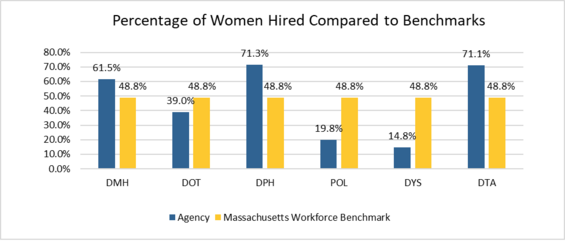
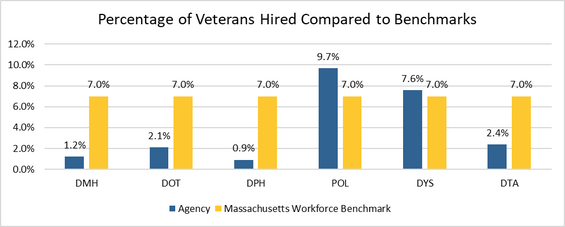
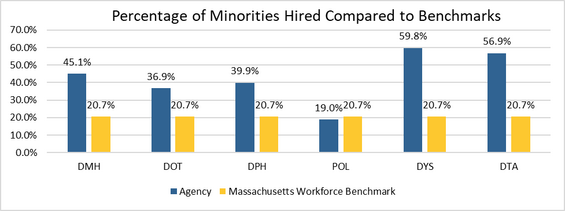
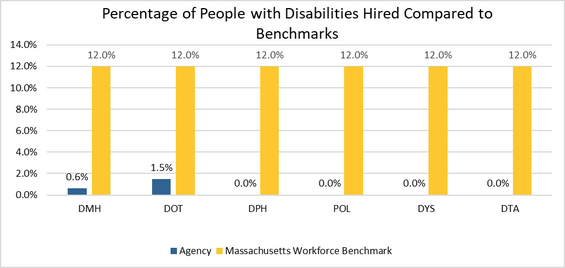
DOT, POL, and DYS were behind in their hiring of women during the audit period. All the agencies were significantly behind in their hiring of people with disabilities. Additionally, DMH, DOT, DPH, and DTA lagged in their hiring of military veterans. However, five agencies exceeded the overall workforce diversity benchmark for minorities, and the sixth nearly met the benchmark.
Authoritative Guidance
Section 3 of EO 526 requires state agencies to complete affirmative action and diversity plans:
All state agencies shall develop and implement affirmative action and diversity plans to identify and eliminate discriminatory barriers in the workplace; remedy the effects of past discriminatory practices; identify, recruit, hire, develop, promote, and retain employees who are members of under-represented groups; and ensure diversity and equal opportunity in all facets, terms, and conditions of state employment. Such plans shall set forth specific goals and timetables for achievement, shall comply with all applicable state and federal laws, and shall be updated, at a minimum, every two years.
HRD issued a memorandum to all executive branch agencies on August 4, 2017 stating that the most recent plans, covering fiscal years 2018 and 2019, were due September 15, 2017.
Section 7 of EO 526 gives the director of HRD’s Office of Diversity and Equal Opportunity (ODEO) the authority to ensure compliance with the EO and impose remedial courses of action on noncompliant agencies:
- Review all such plans and either approve, return for amendment, or reject them . . .
- Where appropriate, determine and impose remedial courses of action, including the potential imposition of a freeze on all personnel requisitions and appointment forms submitted by any non-compliant agency to the Chief Human Resources Officer.
To facilitate the timely filing of these reports, HRD should hold all agencies to the same standard and impose remedial actions on agencies that do not file these reports by established deadlines and have no reasonable explanation for not doing so.
Reasons for Noncompliance
HRD management told us that all noncompliant agencies were in communication with HRD about becoming compliant when submitting their fiscal year 2018/2019 plans and that therefore HRD did not believe it was necessary to take any remedial actions. HRD management also told us that they take the following steps to ensure that agencies comply with EO 526:
- contacting agencies’ diversity officers to understand the cause of the noncompliance
- establishing reasonable timelines for agencies to become compliant
- offering technical assistance on the completion of plans
- referring matters to agency management to ensure accountability
- imposing freezes on personnel requisitions (as a last resort)
However, HRD could not provide us with any documentation to substantiate that it had implemented any of these measures. Further, HRD does not have any policies or procedures regarding imposing remedial measures on noncompliant agencies.
Recommendations
- HRD should establish policies and procedures for ODEO to ensure that its staff consistently enforces agency compliance with EO 526. The policies and procedures should include a policy regarding imposing remedial courses of action, such as hiring freezes, on agencies that do not comply with EO 526.
- HRD should implement monitoring controls to ensure that these policies and procedures are adhered to.
Auditee’s Response
HRD agrees that Affirmative Action and Diversity plans were not always filed in a timely manner. There are multiple factors that may have contributed to an agency’s failure to meet the stated deadlines, which were shared during the audit. HRD and its Office of Diversity and Equal Opportunity (“ODEO”) is committed to improving its control processes and will review its current policies and procedures to make the necessary revisions that will ensure a greater enforcement of timely submission of Affirmative Action and Diversity Plans. Further, we will develop a communication plan to share changes with all Executive Branch agencies alerting them to the policy changes and the consequences of non-compliance moving forward. . . .
Our aim is to have a diverse and inclusive workforce that reflects the population we serve. The total workforce benchmarks are set out in the memo to Executive Department Agency Heads dated August 4, 2017, which was shared with the auditors via email on October 3, 2018. The benchmarks referenced in the memo specify that they relate to the “Total Civilian Labor Workforce.” It is these benchmarks by which we mark our progress, based on representation in the Commonwealth’s overall workforce. The benchmarks are not and have never been related to hiring. In order to illustrate historical progress, we have included the attached table detailing workforce demographics compared to these benchmarks [see table below].
Despite the late submission of plans, the Commonwealth’s overall Total Workforce meets or exceeds stated benchmarks in half of the four protected categories, Women and Minorities. The remaining two categories, Veterans and Persons with Disabilities, require employee self-identification. At least annually, Veterans and Persons with Disabilities are invited to self-identify by their agencies. Self-Identification is a completely voluntary process in which some employees participate, but many do not. It is our belief that due to the voluntary nature of self-identification, the stated numbers underrepresent the true nature of our workforce despite our best recruitment and hiring efforts. . . .
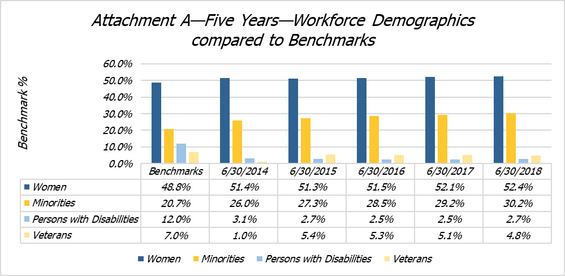
Auditor’s Reply
We agree with HRD that the benchmarks mentioned in this finding are used by HRD in analyzing diversity across the total workforce of the Commonwealth. Accordingly, our report states that we compared the state’s overall workforce diversity benchmarks against hiring by the six agencies that had conducted most of the hiring during the period July 1, 2016 through December 31, 2017 but had not submitted affirmative action and/or diversity plans as of May 25, 2018.
Further, we do not dispute HRD’s assertion that because veterans and people with disabilities are invited to identify themselves as belonging to these categories, their numbers in the overall workforce and in the executive branch may be understated. The focus of our audit was not on whether executive branch agencies met workforce diversity benchmarks, but on how effectively HRD administered the process of ensuring that executive agencies met the report filing requirements of EO 526. As noted above, we found that despite the significant number of executive branch agencies HRD identified through monitoring that did not file the required plans, HRD had not taken any remedial actions to enforce agency compliance and therefore, in the Office of the State Auditor’s opinion, the Commonwealth cannot be sure that its executive branch agencies are taking the measures necessary to achieve all the intended results of EO 526.
However, based on its response, HRD is taking measures to ensure that executive branch agencies file required affirmative action and diversity plans in a timely manner.
| Date published: | February 14, 2019 |
|---|